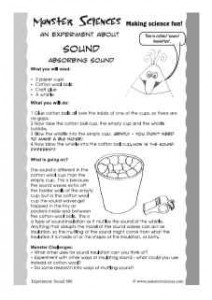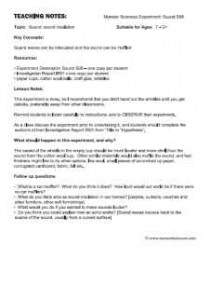Investigate how to make sound insulation by muffling the sound of a whistle with cotton balls.
 |
 |
An experiment about Sound: Absorbing Sound
What you will need:
• 2 paper cups
• Cotton wool balls
• Craft glue
• A whistle
What you will do:
1 Glue cotton balls all over the inside of one of the cups, so there are no gaps.
2 Now take the cotton ball cup, the empty cup and the whistle outside.
3 Blow the whistle into the empty cup. Gently – you don’t need to make a big noise!
4 Now blow the whistle into the cotton ball cup. How is the sound different?
What is going on?
The sound is different in the cotton wool cup than the empty cup. This is because the sound waves echo off the harder walls of the empty cup, but in the cotton wool cup the sound waves get trapped in the tiny air pockets inside and between the cotton wool balls. This is a type of sound insulation as it muffles the sound of the whistle. Anything that disrupts the travel of the sound waves can act as insulation, so the muffling of the sound might come from what the insulation it is made of or the shape of the insulation, or both.
Monster Challenges:
• What other uses for sound insulation can you think of?
• Experiment with other ways of insulating sound – what could you use instead of cotton wool?
• Do some research into ways of muffling sound?
TEACHING NOTES: Monster Sciences Experiment: Sound S08
Topic:
Sound: sound insulation
Key Concepts:
Sound waves can be interupted and the sound can be muffled.
Resources:
• Experiment Description Sound S08 – one copy per student
• Investigation Report IR01 – one copy per student
• paper cups, cotton wool balls, craft glue, whistles
Lesson Notes:
This experiment is noisy, so I recommend that you don’t hand out the whistles until you get outside, preferably away from other classrooms.
Remind students to listen carefully to instructions, and to OBSERVE their experiment.
As a class discuss the experiment prior to undertaking it, and students should complete the sections of their Investigation Report IR01 from ”Title to “Hypothesis”.
What should happen in this experiment, and why?
The sound of the whistle in the empty cup should be much louder and more shrill than the sound from the cotton wool cup. Other similar materials would also muffle the sound, and fast finishers might like to try other options, like wool, small pieces of scrunched up paper, corrugated cardboard, fabric, felt etc.
Follow up questions:
• What is a car muffler? What do you think it does? How loud would our world be if there were no car mufflers?
• What do you think acts as sound insulation in our homes? [carpets, curtains, couches and other furniture, other soft furnishings]
• What would you do if you wanted to make sounds louder?
• Do you think you could explain how an echo works? [Sound waves bounce back to the source of the sound, usually from a curved surface]
© www.monstersciences.com



